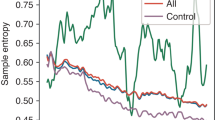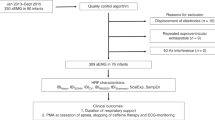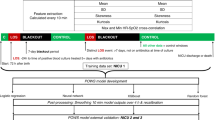Abstract
Background
Heart rate (HR) patterns can inform on central nervous system dysfunction. We previously used highly comparative time series analysis (HCTSA) to identify HR patterns predicting mortality among patients in the neonatal intensive care unit (NICU) and now use this methodology to discover patterns predicting cerebral palsy (CP) in preterm infants.
Method
We studied NICU patients <37 weeks’ gestation with archived every-2-s HR data throughout the NICU stay and with or without later diagnosis of CP (n = 57 CP and 1119 no CP). We performed HCTSA of >2000 HR metrics and identified 24 metrics analyzed on HR data from two 7-day periods: week 1 and 37 weeks’ postmenstrual age (week 1, week 37). Multivariate modeling was used to optimize a parsimonious prediction model.
Results
Week 1 HR metrics with maximum AUC for CP prediction reflected low variability, including “RobustSD” (AUC 0.826; 0.772–0.870). At week 37, high values of a novel HR metric, “LongSD3,” the cubed value of the difference in HR values 100 s apart, were added to week 1 HR metrics for CP prediction. A combined birthweight + early and late HR model had AUC 0.853 (0.805–0.892).
Conclusions
Using HCTSA, we discovered novel HR metrics and created a parsimonious model for CP prediction in preterm NICU patients.
Impact
-
We discovered new heart rate characteristics predicting CP in preterm infants.
-
Using every-2-s HR from two 7-day periods and highly comparative time series analysis, we found a measure of low variability HR week 1 after birth and a pattern of recurrent acceleration in HR at term corrected age that predicted CP.
-
Combined clinical and early and late HR features had AUC 0.853 for CP prediction.
This is a preview of subscription content, access via your institution
Access options
Subscribe to this journal
Receive 14 print issues and online access
$259.00 per year
only $18.50 per issue
Buy this article
- Purchase on Springer Link
- Instant access to full article PDF
Prices may be subject to local taxes which are calculated during checkout


Similar content being viewed by others
Data availability
Anonymized HR HCTSA data on UVA NICU patients, with the evidence graph for the clustering, are openly available in the University of Virginia’s LibraData archive at https://doi.org/10.18130/V3/VJXODP.
Code availability
Python code used to process this data is archived in Zenodo at https://doi.org/10.5281/zenodo.4321332. This version and any future versions are also available on GitHub at https://github.com/fairscape/hctsa-py. Our code is licensed under terms of the MIT license (https://opensource.org/licenses/MIT), and is a reimplementation in Python of most of Ben Fulcher’s original MATLAB code, available here: https://github.com/benfulcher/hctsa. Software for clustering analysis and cross-implementation testing, together with the test data, may be found here: https://doi.org/10.5281/zenodo.4627625.
References
Korzeniewski, S. J., Slaughter, J., Lenski, M., Haak, P. & Paneth, N. The complex aetiology of cerebral palsy. Nat. Rev. Neurol. 14, 528–543 (2018).
Sadowska, M., Sarecka-Hujar, B. & Kopyta, I. Cerebral palsy: current opinions on definition, epidemiology, risk factors, classification and treatment options. Neuropsychiatr. Dis. Treat. 16, 1505–1518 (2020).
Novak, I. et al. Early, accurate diagnosis and early intervention in cerebral palsy: advances in diagnosis and treatment. JAMA Pediatr. 171, 897–907 (2017).
Morgan, C. et al. Early intervention for children aged 0 to 2 years with or at high risk of cerebral palsy: international clinical practice guideline based on systematic reviews. JAMA Pediatr. 175, 846–858 (2021).
Mulkey, S. B. & du Plessis, A. J. Autonomic nervous system development and its impact on neuropsychiatric outcome. Pediatr. Res. 85, 120–126 (2019).
Fairchild, K. D. et al. Abnormal heart rate characteristics are associated with abnormal neuroimaging and outcomes in extremely low birth weight infants. J. Perinatol. 34, 375–379 (2014).
Fairchild, K. D. & O’Shea, T. M. Heart rate characteristics: physiomarkers for detection of late-onset neonatal sepsis. Clin. Perinatol. 37, 581–598 (2010).
Sullivan, B. A. et al. Early heart rate characteristics predict death and morbidities in preterm infants. J. Pediatr. 174, 57–62 (2016).
Vergales, B. D. et al. Depressed heart rate variability is associated with abnormal EEG, MRI, and death in neonates with hypoxic ischemic encephalopathy. Am. J. Perinatol. 31, 855–862 (2014).
Zanelli, S. A. et al. Early vital sign differences in very low birth weight infants with severe intraventricular hemorrhage. Am. J. Perinatol. 40, 1193–1201. https://doi.org/10.1055/s-0041-1733955 (2023).
Letzkus, L. et al. Heart rate and pulse oximetry dynamics in the first week after birth in neonatal intensive care unit patients and the risk of cerebral palsy. Am. J. Perinatol. https://doi.org/10.1055/s-0042-1756335 (2022).
Niestroy, J. C. et al. Discovery of signatures of fatal neonatal illness in vital signs using highly comparative time-series analysis. npj Digit. Med. 5, 6 (2022).
Fulcher, B. D. & Jones, N. S. hctsa: a computational framework for automated time-series phenotyping using massive feature extraction. Cell Syst. 5, 527–531.e3 (2017).
Fulcher, B. D., Little, M. A. & Jones, N. S. Highly comparative time-series analysis: the empirical structure of time series and their methods. J. R. Soc. Interface 10, 20130048 (2013).
Elliott, M. et al. Effect of dexmedetomidine on heart rate in neonates with hypoxic ischemic encephalopathy undergoing therapeutic hypothermia. J. Neonatal Perinat. Med. 15, 47–54 (2022).
Blackard, K.R., Krahn, K.N., Andris, R.T., Lake, D.E. & Fairchild, K.D. Autism risk in neonatal intensive care unit patients associated with novel heart rate patterns. Pediatr. Res. 90, 1186–1192. https://doi.org/10.1038/s41390-021-01381-1 (2021).
Kumar, N., Akangire, G., Sullivan, B., Fairchild, K. & Sampath, V. Continuous vital sign analysis for predicting and preventing neonatal diseases in the twenty-first century: big data to the forefront. Pediatr. Res. 87, 210–220 (2020).
Andersen, M., Andelius, T. C. K., Pedersen, M. V., Kyng, K. J. & Henriksen, T. B. Severity of hypoxic ischemic encephalopathy and heart rate variability in neonates: a systematic review. BMC Pediatr. 19, 242 (2019).
Bersani, I. et al. Heart rate variability as possible marker of brain damage in neonates with hypoxic ischemic encephalopathy: a systematic review. Eur. J. Pediatr. 180, 1335–1345 (2021).
Goswami, I. et al. Early neonatal heart rate variability patterns in different subtypes of perinatal hypoxic-ischemic brain injury. Pediatr. Res. 92, 1630–1639. https://doi.org/10.1038/s41390-022-02016-9 (2022).
Epstein, S. et al. Preterm infants with severe brain injury demonstrate unstable physiological responses during maternal singing with music therapy: a randomized controlled study. Eur. J. Pediatr. 180, 1403–1412 (2021).
Pavel, A. M. et al. Heart rate variability analysis for the prediction of EEG grade in infants with hypoxic ischaemic encephalopathy within the first 12h of birth. Front. Pediatr. 10, 1016211 (2022).
Rother, M., Witte, H., Zwiener, U., Eiselt, M. & Fischer, P. Cardiac aliasing – a possible cause for the misinterpretation of cardiorespirographic data in neonates. Early Hum. Dev. 20, 1–12 (1989).
Jarvis, S. et al. Case gender and severity in cerebral palsy varies with intrauterine growth. Arch. Dis. Child 90, 474–479 (2005).
Hintz, S. R. et al. Gender differences in neurodevelopmental outcomes among extremely preterm, extremely-low-birthweight infants. Acta Paediatr. 95, 1239–1248 (2006).
Romeo, D. M. et al. Sex differences in cerebral palsy on neuromotor outcome: a critical review. Dev. Med. Child Neurol. 58, 809–813 (2016).
Goulding, R. M. et al. Heart rate variability in hypoxic ischemic encephalopathy: correlation with EEG grade and 2-y neurodevelopmental outcome. Pediatr. Res. 77, 681–687 (2015).
Oliveira, V. et al. Prognostic accuracy of heart rate variability analysis in neonatal encephalopathy: a systematic review. Neonatology 115, 59–67 (2019).
Metzler, M. et al. Pattern of brain injury and depressed heart rate variability in newborns with hypoxic ischemic encephalopathy. Pediatr. Res. 82, 438–443 (2017).
Sadowska, M., Sarecka-Hujar, B. & Kopyta, I. Analysis of selected risk factors depending on the type of cerebral palsy. Brain Sci. 11, 1448. https://doi.org/10.3390/brainsci11111448 (2021).
Alonzo, C. J. et al. High prevalence of abnormal general movements in hospitalized very low birth weight infants. Am. J. Perinatol. 29, 1541–1547 (2022).
Ferrari, F. et al. Cramped synchronized general movements in preterm infants as an early marker for cerebral palsy. Arch. Pediatr. Adolesc. Med. 156, 460–467 (2002).
Funding
L.L. is an iTHRIV Scholar. The iTHRIV Scholars Program is supported in part by the National Center for Advancing Translational Sciences of the National Institutes of Health under Award Numbers UL1TR003015 and KL2TR003016. L.L. also received funding from AACPDM Pedal with Pete for this project.
Author information
Authors and Affiliations
Contributions
L.L., G.L., J.B., D.L., and K.F. contributed to the design and implementation of the research, to the analysis of the results, and to the writing of the manuscript. R.P. and S.K. contributed to the data collection and the writing of the manuscript.
Corresponding author
Ethics declarations
Competing interests
The authors declare no competing interests.
Ethics approval and consent to participate
Ethical approval was provided by the Institutional Review Board of University of Virginia in advance of implementation. A waiver of consent was approved. Patient consent was not required.
Additional information
Publisher’s note Springer Nature remains neutral with regard to jurisdictional claims in published maps and institutional affiliations.
Rights and permissions
Springer Nature or its licensor (e.g. a society or other partner) holds exclusive rights to this article under a publishing agreement with the author(s) or other rightsholder(s); author self-archiving of the accepted manuscript version of this article is solely governed by the terms of such publishing agreement and applicable law.
About this article
Cite this article
Letzkus, L., Picavia, R., Lyons, G. et al. Heart rate patterns predicting cerebral palsy in preterm infants. Pediatr Res (2023). https://doi.org/10.1038/s41390-023-02853-2
Received:
Revised:
Accepted:
Published:
DOI: https://doi.org/10.1038/s41390-023-02853-2
This article is cited by
-
Monitoring chaos at the cot-side
Pediatric Research (2024)
-
When is a potential new screening algorithm ready for translation?
Pediatric Research (2023)



